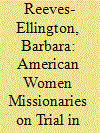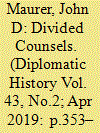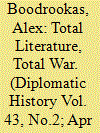|
|
|
Sort Order |
|
|
|
Items / Page
|
|
|
|
|
|
|
| Srl | Item |
| 1 |
ID:
165800


|
|
|
|
|
| Summary/Abstract |
In 1927, over 12,000 blue-eyed American dolls travelled across the Pacific as gifts of friendship to Japanese children. In response, fifty-eight exorbitantly expensive Japanese dolls bearing a similar message were sent on the opposite journey. This curious spectacle, an early attempt at trans-Pacific cultural exchange, is still part of popular memory in Japan, although it has been largely forgotten in the United States.
|
|
|
|
|
|
|
|
|
|
|
|
|
|
|
|
| 2 |
ID:
165798


|
|
|
|
|
| Summary/Abstract |
On April 30, 1928, a court in the town of Bursa, Republic of Turkey, found three American mission-school teachers guilty of proselytizing in contravention of Turkish law.1 Edith Sanderson, Lucille Day, and Jeannie Jillson received a light punishment, a small fine, and a three-day imprisonment, which they were allowed to serve by being confined to school grounds. Yet the leniency of the judgment belied the magnitude of the case during a tectonic shift in local politics that reverberated across the Atlantic.
|
|
|
|
|
|
|
|
|
|
|
|
|
|
|
|
| 3 |
ID:
165803


|
|
|
|
|
| Summary/Abstract |
Despite the effort that went into strategizing and negotiating arms control during the Cold War, U.S. leaders remained divided over arms control’s intent and fundamental purpose. While there was general agreement that arms control should aim to avoid war, limit destructiveness, and decrease the costs of armaments, significant differences existed on the best specific policies to achieve these objectives.1 In approaching arms control negotiations, two schools of thought emerged by the late 1960s, when the Nixon administration came into office and began formulating its policies to guide the upcoming Strategic Arms Limitation Talks (SALT). One school that can be labeled the “assured destruction approach” believed negotiations with the Soviets should be used to limit dangerous first-strike weapons.2 Meanwhile, a second school that can be called the “competitive strategies approach” maintained that arms limitation talks could be used by the United States to gain strategic advantage over the Soviet Union.3 These competing approaches divided an already disputatious administration, and even amid the successes of détente and the SALT talks sowed doubt about the ultimate goals of improved relations with the Soviet Union and the de-escalation of the arms race. The following pages will describe the origins and nature of the Nixon administration’s philosophical split over arms control fundamentals, and the personal and political rivalries it engendered.
The Purposes of Ar
|
|
|
|
|
|
|
|
|
|
|
|
|
|
|
|
| 4 |
ID:
165799


|
|
|
|
|
| Summary/Abstract |
In September 1918, the medical personnel from Soochow Medical College for Women, a Southern Methodist missionary medical school in Suzhou, China, set out for Vladivostok, Siberia, in response to a call from the newly established American Red Cross unit to aid with the refugee emergency in that city. While the Red Cross had originally been set up to help with the medical needs of the Czechoslovakian and anti-Bolshevik Russian military forces then controlling Siberia and of the American Expeditionary Forces, the refugees who had fled from the Bolshevik controlled regions of Russia to Siberia constituted a humanitarian crisis that came to form a major part of the work of the Red Cross. Because of their relative proximity to Siberia, most of the original medical personnel were “recruited from among American expat missionary and medical communities and their native employees” in East Asia, the Philippines, and Hawaii.1 The Red Cross asked the women missionary physicians at the Soochow Medical College for Women to come to Vladivostok to take care of the women and children refugees. After some consideration, two American women physicians, an American nurse, two Chinese women physicians, and one Chinese woman pharmacist who had been trained at the school, along with the five women medical students and five nursing students, left for Vladivostok in September, remaining for six months until April of 1919.
|
|
|
|
|
|
|
|
|
|
|
|
|
|
|
|
| 5 |
ID:
165797


|
|
|
|
|
| Summary/Abstract |
The forum in this issue of Diplomatic History interweaves several strands in the study of U.S. foreign relations. All three papers focus on the decade after World War I, a transformative era in U.S. and global history alike, which has attracted renewed scholarly attention, particularly regarding the origins of international humanitarianism.
|
|
|
|
|
|
|
|
|
|
|
|
|
|
|
|
| 6 |
ID:
165801


|
|
|
|
|
| Summary/Abstract |
On April 13, 1978, Bishop Jim Jones of the Peoples Temple of the Disciples of Christ addressed his congregation in the hinterlands of Guyana, where five years earlier he and his parishioners negotiated the establishment of a remote jungle commune. Jones, who moved to Guyana permanently in the summer of 1977, did not take well to life in the wilderness and his health suffered. He was no longer the handsome and robust preacher who had entertained vice presidential nominee Walter Mondale in 1976; his face was pale and bloated, he was feverish and exhausted, and he spoke with a slight slur.1 Not surprisingly, Jones chose to address his health when he began his speech. “I don’t even recall having one blackout,” he stated plainly. “Didn’t get dizzy, just shook my head from the pain, but I did not [pass out], so don’t get nervous with your blood pressure. Some of you folk worry about blood pressure? Shit, you ain’t got blood pressure.
|
|
|
|
|
|
|
|
|
|
|
|
|
|
|
|
| 7 |
ID:
165802


|
|
|
|
|
| Summary/Abstract |
While scholars of the Cold War have long critiqued the relationship between the academy and the U.S. security apparatus, research libraries have largely escaped interrogation.1 Libraries have not elicited calls to read “against the grain”; the contingencies and pressures that shaped their collections remain unexplored.2 This paper traces the connections between national security, information science, and area studies through a history of the vast overseas collections of U.S. research libraries, particularly from South Asia and the Middle East. Created by an unlikely alliance of librarians, defense agencies, foundations, and lobbyists, they are a testament to the enduring influence of national security priorities on the production of academic knowledge. Indeed, as this paper shows, they are an enduring legacy of the Cold War state—a legacy that continues to shape the contours of scholarship.
|
|
|
|
|
|
|
|
|
|
|
|
|
|
|
|
|
|
|
|
|